How to Explain Racism to Children – Teach Them about Tolerance
The coronavirus pandemic is not yet finished, local and international media is livened up with protests by US citizens. Thousands of masses in various cities took to the streets demanding justice due to the murder case by several police officers to an African-American citizen, George Floyd.
As a result of the ongoing quarantine and more time at home, some children might wonder about the ins and outs of this protest they see on television. Therefore, it is important to know how to explain racism to children and teach them about tolerance. This is all aimed at making them understand what is happening, and as much as possible avoiding racist acts in the future.
How to Explain Racism to Children – Teach Them about Tolerance
With the emergence of diverse backgrounds and characters, racism is also flourishing. Without proper education, children who are not yet fully able to process information can act without conscious awareness of racism. This is why parents need to explain racism to children from an early age.
Racism is not only in the form of violence. Simple things like jokes can become a forum for this behavior.
Education about racism can help your child recognize which attitudes are good and bad as their social development.
It is also a good thing to learn so that there won’t be more people who become fall victims of racial trauma and suffer from mental disorders such as depression, PTSD, etc.
====> Attitude of Gratitude Subliminal <====
How to explain racism to children
Racism is not a simple topic. You may need to chat with your child several times until they understand the meaning.
Quoted from the New York Times, Y. Joy Harris-Smith, a lecturer at Princeton Theological Seminary and author of The ABCs of Diversity: Helping Kids (and Ourselves!) Embrace Our Differences, says that parents must tell honest acts of murder and protest, but adjusted for the age level of the child.
To make it easier for you, the following steps can be taken according to their age group:
1. Age 2-5 years
Children have been able to see the difference between themselves and others, but they have not been able to recognize people through race, gender, or ethnicity. They also do not know discrimination against people who are different from them.
If your child never meets people who are different from him or her, he or she will think of them as something foreign. So, take advantage of this moment by introducing as much diversity as possible to the child.
Teach children to make good friends with people of different skin colors and hair, body shapes. Take him/her to eat food that was never made by your family. If possible, try to introduce children to a second language.
You have not been able to clearly explain racism to children. However, you can work around this by:
- Be honest and open. Let your child know that everyone is born different.
- Do not ignore children’s questions about people’s differences.
- Don’t use stereotypes like, “Your friend speaks loudly because he’s Batak (a tribe in Indonesia),” or “Boys shouldn’t play cooking game.”
- Tell your child that you have diverse friends circle (different age, ethnicity, skin colors, etc).
2. Age 6-12 years
Explaining racism to children is easier at this stage, but you shouldn’t be too rigid. Ask what your child heard at school and what he watched on TV today. Establish communication with children by letting them tell as much as possible.
Children at this stage already understand hatred and feelings when they are treated unfairly. They will be surprised every time he or she sees a friend who is bullied or when he or she is not given a ball by his or her friend during sports lessons.
Children will often ask questions that you do not expect. At the same time, they also imitated the way his parents talked and interacted with other people around them.
Here are some tips that you can follow at this stage:
- Be a role model for children by being kind to others regardless of ethnicity, race, religion, and so on.
- Ask the child if he feels different from other people. If yes, ask what makes him feel that way.
- If the child says something racist, don’t just standstill. Ask the reason, then explain that such an attitude is not good.
- Encourage children to watch TV or do activities that can provoke discussion.
3. Age 13-17 years
This is the most important time to explain racism. The reason is, teenagers will gather various information about the people around them to find an identity. He wants to know where he is in social groups.
Older children can have a deeper conversation about issues of racism and prejudice and the role they might play in supporting them. At this age, parents can have more sophisticated discussions on topics such as Black Lives Matter and racial profiles, said Henry, Chairperson of David Lam in Multicultural Education and a professor in the department of language education and literacy at the University of British Columbia.
Teenagers are also inundated with information from the use of social media. Without parental supervision, the use of social media can change the mindset of adolescents. This change might affect them as they mature.
On the other hand, parents sometimes find it difficult to be close to children as teenagers. This happens because teenagers tend to trust their friends more. There is nothing wrong with this, as long as you keep trying to instill positive values in it.
Here are a few tips you can try:
- Keep chatting with children often. Although it seems indifferent, the child still wants to discuss it with his parents.
- Invite him to talk about issues that are hot, such as bullies, celebrities who are viral, and others.
- Introduce children to volunteer activities, extracurricular activities, and so on so that their relationships become wider.
- Make sure your behavior matches the words and advice you give.
Nobody is born with racism. Racism is a behavior that is formed from a sense of insecurity, self-defense mechanisms, and environmental influences. Although its impression is hard to believe, its appearance can begin in childhood.
It is important to explain racism to children. That way, children will understand that everyone has differences and there is nothing wrong with it. The diversity that exists can unite them and others around them.
====> Attitude of Gratitude Subliminal <====
Stop racism! Teach about tolerance from a young age
We all agree that racism is something that cannot be justified. Unfortunately, racism will continue to live if we think that there are better racial classes than other races. This view may be inherited by our children’s generation and actions will continue.
Therefore, educating children about the values of diversity and tolerance is a real way to stop the practices of racism.
If you already know the difference, then what?
At school age, children will begin to make a difference and compare themselves to others. They are in the phase of analyzing differences. It is natural for children to identify differences in skin color, hair shape, body size, or religion.
Now, when they have started to identify comparisons, then what should parents do? This is a good time to teach them about diversity and how to behave in these conditions.
Guide them not to make the wrong conclusion that the differences make a person or group of people better or superior to others. Always instill in children that in this world we are all different and no one is the same.
See the person’s personality
Teach children to see someone based on his personality and attitude, not based on where he came from, what color his skin, or what religion. Children will learn to respect others more fully with this.
Empathy is a key
One of the keys to tolerance is empathy. Encourage children to dialogue by guessing how the feelings of others who get treated are distinguished, removed, or intimidated just because they are a minority.
Invite them to assume themselves in the person’s position. “How would you feel if you are treated badly? You don’t like it, right? That is exactly why it is important to treat others just like we want to be treated.”
Dare to stand up
As parents, we should also show our children how to stand up when they see unfairness or falsity. For example, when there are friends who are ridiculed by other friends because of racial differences.
We have to empower children to say no to the wrong things they find every day. Make sure that standing up to say ‘that’s wrong’ will not make them face problems or be in trouble.
Bottom line
The journal, published by Clinical Psychiatry News, says that racism is largely a learned behavior. Racism in the broadest sense is probably an adaptive human behavior. Because naturally, humans will be difficult to control their fear of strangers. Humans also try to protect their own territories to maintain their survival.
Thus, families play an important role in educating their children not to act racist. In addition to maintaining an open dialogue about racism, ways to raise anti-racist children can be done by providing anti-racist education through various media, such as films, or reading books. Choose some media that implies to children that all humans must be treated equally, regardless of skin color.
However, words and books should not be the end of children’s education about race and racism. Parents also need to be a model for children regarding anti-racism attitudes, behaviors, and values.
It’s not enough to just talk about racism, you have to try hard to be anti-racist and fight against unfair policies and practices.
Say no to discrimination!
Say no to racism!
Stay safe, happy, and healthy!

—————————————————————————————————————————————–
This post may contain affiliate links, which means I make a small commission off purchases, at no extra cost to you. Read my full disclosure here. Thank you for supporting the work I put on this site!
—————————————————————————————————————————————–
We Stress Free does not provide medical advice, diagnosis, or treatment. However, if you need someone to talk to and want to make friends, please feel free to reach me at ferra@westressfree.com. If you would like to REDUCE your STRESS and are interested to do an ONLINE THERAPY, you can do so here.
———————————————————————————————————-—————————-
Disclaimer: The information contained in this website is for educational and informational purposes only and is not intended as health or medical advice. Always consult a physician or other qualified health provider regarding any questions you may have about a medical condition or health objectives.
Thank you for reading today’s topic: How to Explain Racism to Children – Teach Them about Tolerance

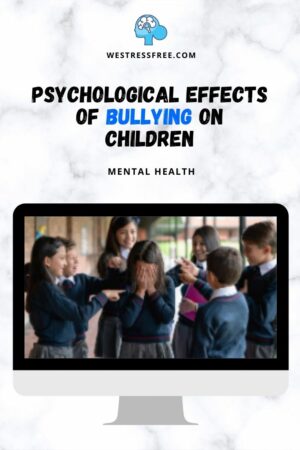
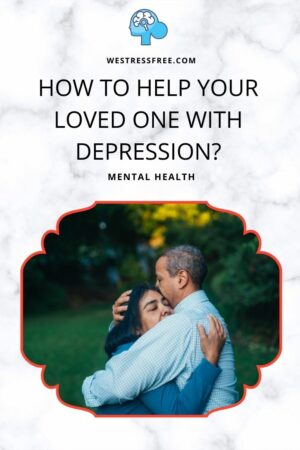





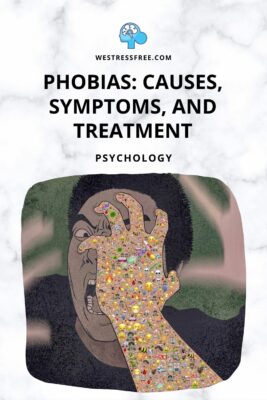

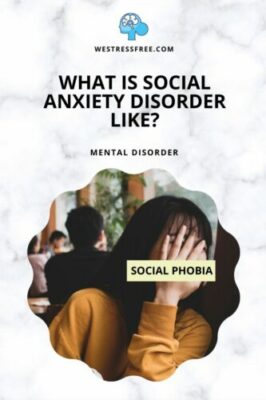
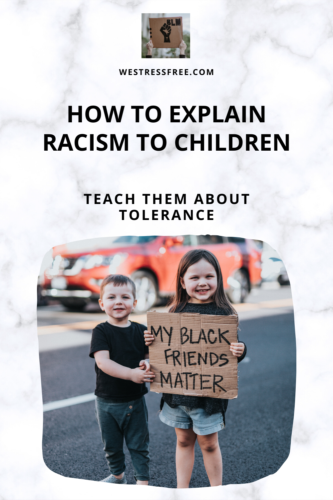
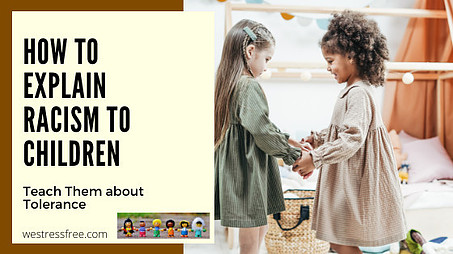
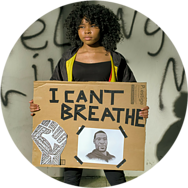


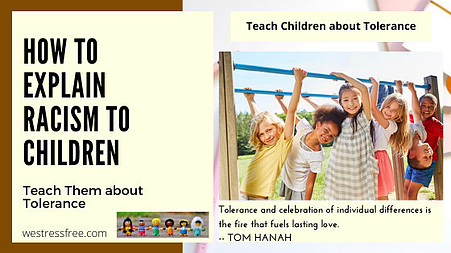



Hi.
Valuable article in the current world. it is most important time to explain racism to children correctly when we consider the local and international examples. I accept as in the article that ” introduce children to volunteer activities, extracurricular activities, and so on so that their relationships become wider”.
Hi Jayantha,
Thank you for visiting my site and reading this post.
Glad to know that you found this post useful to educate people about racism. 🙂
Yes, that’s right. By going volunteering and joining extracurricular activities, children can widen their connections and friendship circles. They can also learn to appreciate the differences and still make good friends with whoever they meet at those places.
Stay safe, happy, and healthy!
Ferra
What a wonderful post! With everything going on, this is an important topic to sit down and teach our children. I love how you mention being a role model because our children learn their behavior first from us. Keep up the good work!
Hi Melissa,
Thank you for visiting my site and reading this post.
Glad to know that you found this post useful. 🙂
I really appreciate your kind words, sharing, and support.
Stay safe, happy, and healthy!
Ferra
This is such an important topic at all times, but especially relevant right now!
We are in South Africa, with our history of apartheid and still such a high level of inequality. My kids are 8 and 6 years old and we do talk about racism quite a bit.
It is not a simple or easy topic to talk about but I make sure to broach the subject with my kids whenever I can.
Hi Lynne,
Thank you for visiting my site and reading this post.
Glad to know that you found this post useful. 🙂 Happy to hear you do talk about this hard topic with your children. I believe they’ll be wonderful human beings once they grow up.
I really appreciate your kind words, sharing, and support.
Stay safe, happy, and healthy!
Ferra
My child is a grown up now and has close friends from many different ethnicities, young people of different cultures, different skin colors, as her father and I do ourselves. I like what you are saying about treating others-we also embraced the: “Treat others as you would like to be treated”-from early childhood.
I must admit I never thought of a need to actually initiate a specific conversation with her about equality or racism, it never occurred to me. Now, that I’ve read your article, I realise we were lucky enough to be surrounded by a lot of different people, so she could sort of naturally “pick up” our attitude towards all of them and effortlessly develop the sense of equality and love for all people regardless of their diversity. I also realise now, not everyone is in that lucky position to grow in such environment. Children who might not interact with a different person very often, need to be guided and educated by their parents, as you excellently describe here. I hope many will read this noble article and use it as a starting point to make some difference in the way children will treat, resist and even fight racism.
Hi Minaher,
Thank you for visiting my site and reading this post.
Glad to know that you found this post useful in raising people’s awareness of the importance of teaching children to be compassionate and stay away from being a racist. 🙂
I really appreciate your kind words, sharing, and support.
Stay safe, happy, and healthy!
Ferra
Thank you for this post, my wife and I have been asking ourselves if we need to have this discussion with our kids or not. After reading all the points you made I think we will and you just made it a little easier for us.
I really hate that in 2020 this is even a topic we need to be discussing with our kids, how are people so archaic still that they can’t understand we are all the same, all the same species, all treated fairly.
Thanks for touching on the topic everyone seems to want to avoid,
Tyler
Hi Tyler,
Thank you for visiting my site and reading this post.
Glad to know that you found this post useful. 🙂
I agree with you. We are all the same species. My husband always tells me if people ask you what race are you, tell them, human. My race is human, just like you.
I really appreciate your kind words, sharing, and support.
Stay safe, happy, and healthy!
Ferra
This can help with the kids at certain ages and keep explaining it to them. And keep them informed of all the things that are going on at the appropriate age. This can take effect at young ages if taught to one another the right way is there a right way? But the important thing is to teach them we are all equal no matter race we all bleed blood.
Cheers,
Mathew&Deloris
Hi Mathew and Deloris,
Thank you for visiting my site and reading this post.
Glad to know that you found this post useful. 🙂
There are no right ways when it comes to teaching our own children. We are the parents, so we know them better.
However, you’re right. The only thing that matters is that we tell them we are all the same, no matter what race, skin colors, etc, we are all human after all.
I really appreciate your kind words, sharing, and support.
Stay safe, happy, and healthy!
Ferra
Great article, Ferra.
If we teach our children how to respect, be tolerant and profess social and racial equality we wouldn’t have all the problems we are having nowadays.
Hi Daniel,
Thank you for visiting my site and reading this post.
Glad to know that you found this post useful. 🙂
I really appreciate your kind words, sharing, and support.
Stay safe, happy, and healthy!
Ferra
I truly appreciate you writing this article, Ferra. All education begins at home, and we often find that racist individuals develop such mindsets from their parents, siblings, and other relatives. While we are all different, God fearfully and wonderfully created each one of us, and he loves all of us equally. Our differences make us special and make life interesting; children have a wonderful innocence about them where they don’t see color, they just see their good friend. I have these conversations with my younger cousins, and it’s definitely making a difference. We must be the change that we want to see in the world. God bless you!
Hi C.N.,
Thank you for visiting my site and reading this post.
I love your comment. God created us with all of His love. He loves each one of us no matter what. We are all the same in His eyes.
Glad to know that you found this post useful. 🙂
I really appreciate your kind words, sharing, and support.
Stay safe, happy, and healthy!
Ferra
There could not be a more relevant topic to address during this time! Not only racism, but the approach we should be taking when explaining it to our children as we instill values that will cultivate the cherishing, not the despising of the diversity of humanity on earth. Hatred of any form is dark and heavy. You mentioned empathy. well, empathy is now known to be one of the healthiest behaviors and mindsets for us to have. It’s kin, compassion, is at the top of that list. What a valuable lesson for our youngsters to learn to have compassion and empathy for others.
Great and timely article. Thanks for the post!
Darrin
Hi Darrin,
Thank you for stopping by my website, reading the post, and leaving a kind comment.
I agree with you. Compassion and empathy are like two great things that we all should have so the world can be a better place for all.
I appreciate you for sharing your thoughts and support.
Stay safe, happy, and healthy!
Ferra
Hello Ferra; I am in total agreement with you on the topic of Racism. There is a saying that goes this way: “children live what they learn, and learn what they live”. If more parents will become active in living and teaching their children about the dangers of racism there will be less racist conflict in the world.
I like to use natural things to bring life to my concept. I looked at the chickens on some farms. And I know of a fact that chicken meat has its own taste regardless of how it is prepared, it will not taste like beef or fish. Yet the chickens are of many different colours, shapes, and sizes. This is a strong example to use when teaching any age group of children about racism.
DorcasW
Hi Dorcas,
Thank you for stopping by my website, reading the post, and leaving a kind comment.
Love the way you use natural things to bring life to your concept. What a great idea! 🙂
I appreciate you for sharing your thoughts and support.
Stay safe, happy, and healthy!
Ferra